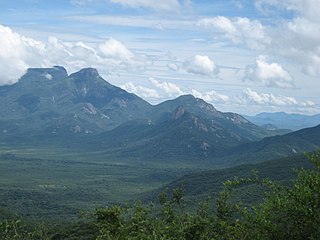
Benguela is a province of Angola, situated in the west of the country. It lies on the Atlantic Ocean, and borders the provinces of Cuanza Sul, Namibe, Huila, and Huambo. The province has an area of 39,826 square kilometres (15,377 sq mi) and its capital is Benguela. According to the 2014 census, there were 2,231,385 inhabitants in the province. The current governor of Benguela is Isaac dos Anjos.

Huíla is a province of Angola. It has an area of 79,023 square kilometres (30,511 sq mi) and a population of 2,497,422. Lubango is the capital of the province. Basket-making is a significant industry in the province; many make baskets out of reeds.

Moçâmedes is a city in southwestern Angola, capital of Namibe Province. The city's current population is 255,000. Founded in 1840 by the Portuguese colonial administration, the city was named Namibe between 1985 and 2016. Moçâmedes has a cool dry climate and desert vegetation, because it is near the Namib Desert.

Namibe Province is a province of Angola. Under Portuguese rule it was the Moçâmedes District. It has an area of 57,091 km2 and had a 2014 census population of 495,326. The port and city of Moçâmedes is the capital of the province with a population of 250,000 in 2014. Iona National Park lies within the province.
The Angolan football Cup is the main "knockout" cup competition in Angolan football.

Atlético Desportivo Petróleos do Namibe, formerly Onze Bravos do Sacomar and Desportivo Sonangol do Namibe and simply known as Atlético do Namibe, named after its major sponsor Sonangol, is Angolan football club based in Moçâmedes, the capital city of the Namibe Province. The name change took place in June 2005. The team play their home games at the Estádio Joaquim Morais. Its major achievements include 2 Angola cup titles won in 2001 and 2004. The club was relegated from the Angolan Premier Division, Girabola in the end of the 2007 championship.
Estádio Joaquim Morais is a multi-use stadium in Moçâmedes, Angola. It is currently used mostly for football matches and serves as the home of Atlético Petróleos do Namibe. The stadium hosted top flight Girabola matches between 2001 and 2007. The stadium holds around 3,000 people.

Tômbua, formerly known as Porto Alexandre, is a city and municipality in Angola, in Namibe Province. The municipality has a population of 55,494 and the city has a population of 46,573 in 2014. It is located on the shore of Porto Alexandre, an important harbor on the South Atlantic Ocean for oil production and fishing.

Bibala is a town, with a population of 10,500 (2014), and a municipality in southern Angola. It lies in Namibe Province. The municipality of Bibala covers 7,700 square kilometres (3,000 sq mi) with a population of 64,504 (2014).

The Communes of Angola are administrative units in Angola after municipalities. The 163 municipalities of Angola are divided into communes. There are a total of 618 communes of Angola:
Virei is a town and municipality of Namibe Province, Angola. It has an area of 15,092 km2. The municipality had a population of 32,445 in 2014.

The Moçâmedes Railway is an 860 km railway line in Angola, between Moçâmedes and Menongue. The line is operated by the company Caminhos de Ferro de Moçâmedes E.P. The port city of Moçâmedes was renamed Namibe between 1985 and 2016, so the railway was sometimes called the Namibe Railway. However, the railway company retained its original legal name.
The Roman Catholic Diocese of Namibe is a Latin diocese in the Angolan Namibe Province.
The 2014 Girabola was the 36th season of top-tier football league in Angola. The season ran from 21 February to 8 November 2014. Kabuscorp were the defending champions, having won their first Angolan championship in 2013.

Cardiocorax is an extinct genus of elasmosaurid known from the Late Cretaceous Mocuio Formation of Namibe Province, southern Angola. It contains a single species, Cardiocorax mukulu.
Baía de Namibe or Little Fish Bay is a bay in Angola. It is located in the Namibe Province.
The 2004 Taça de Angola was the 23rd edition of the Taça de Angola, the second most important and the top knock-out football club competition following the Girabola. Sonangol do Namibe beat Primeiro de Agosto 2-0 in the final to secure its second title.
The 2001 Taça de Angola was the 20th edition of the Taça de Angola, the second most important and the top knock-out football club competition following the Girabola. Sonangol do Namibe beat Sporting de Cabinda 3-2 in the final to secure its 1st title.
The 2000 Taça de Angola was the 19th edition of the Taça de Angola, the second most important and the top knock-out football club competition following the Girabola. Petro de Luanda beat Inter de Luanda 1-0 in the final to secure its 7th title.

Saint Martin of the Tigers, sometimes referred to simply as Village of Tigres Bay, is a ghost town in southern Angola, located on Tigres Island, currently separated from the Angolan mainland by the Tigres Strait. For legal purposes it is also a commune in the municipality of Tômbua, in the province of Namibe.











